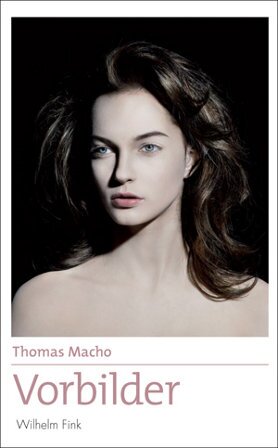Thomas Macho
Vorbilder
[Role models]
Sample translations
Review
A commonplace observation in the area of cultural criticism holds that with the advent of modernism there came a pervasive loss of form and an increasing lack of standards and ideals. Once religious and institutionalized values lost their binding force, according to this view, chaos, disorientation and existential confusion were the counterparts to a newly experienced sense of individual freedom. The pace of change and rapidly changing demands overstrained even the most flexible minds.
Thomas Macho, professor of cultural criticism at the Humboldt University in Berlin, stated in the second sentence of his book “Vorbilder” ["Role Models"], that in today’s lifeworld, “forms have lost the little meaning they still possessed.“ A few decades ago, elementary school report cards graded first-graders on their "behavior" and “penmanship." Since then, word processing programs have replaced handwriting skills, and adults who wish to maintain good form - whether calligraphic or in terms of social relations - are seen as suffering from an obsessive-compulsive disorder. And yet, as the clearly paradoxical thesis shows, while modernity may seem chaotic and amorphous, it has been "a triumphal era for forms and role models: in art and reality."
Since antiquity, the Platonic heaven of ideas has been the realm where the ideal triangle is located next to the ideal horse in an ideal place, which today capitalism and globalization have replaced. In the metropolises of western society, people see traces of the new Gods in the form of trademarks and logos. Consumption has become a mass sport and people orient themselves around supermodels and bodybuilders. "Men as well as women dream today in centimeters, and get either extended or enlarged as needed," and cut off whatever does not to correspond to the ideal.
The observation that the advent of mass media engendered an obsession with beauty and the body cult might seem, at first glance, to be rather unspectacular. What is original, however, is the ways in which Macho endows this idea with a distinctive profile: In an associative frenzy, he roams through the history of film, church, philosophy, and everyday life, contrasting the "figurative normative ideal" of the technological era with the "narrative ideal", which, long before the invention of the Internet, television, and print offered stability and orientation.
In one of the seventeen overwhelmingly expansive chapters of the book, he traces the genealogy of the Virgin Mary to Carla Bruni, the former First Lady of France. An important member of this lineage is Joan of Arc. The girl from Lorraine, who led the French army in the Hundred Years War against England, has remained today an uncontested political figure. Jean Marie Le Pen’s right wing Front National claimed the national myth of Joan of Arc for their own, as did the left, who brought the visual topos of the armed virgin together with the image of the revolutionary, bare-breasted Marianne.
The first beauty contest was held in France in 1920. Macho’s observation that Joan of Arc was canonized that same year is by no means an over-interpretation. His flair for cultural history is embedded in the circumstances that led to the boom in beauty pageants during the years after World War I: "Modern weapons had created such an incredible number and variety of injuries and mutilations that nobody needed to see more freak shows," which in the late 19th Century had enjoyed great popularity in town fairs. The generation that lived through World War I literally craved visual rules of conformity and standardized beauty.
Macho is concerned less about the constraints of beauty contests and deformity than with the modern view of role models, which no longer is characterized by its original, temporal dimension. In other words, the forward-looking aspect of the role model has almost completely fallen into oblivion. Even if each era necessarily comes to an end, we still need idols, precursors, or role models.
In the most irritating chapter of this richly and impressively illustrated volume, Macho deals with the macabre role model function of celebrity and fictional suicides. During Goethe's lifetime, there were at least a dozen Werther readers who had committed suicide. They were found wearing a blue tail coat and yellow vest – just as the hero of the epistolary novel had worn, along with the novel opened on the table in front of them. In 2009, when the suicide of soccer player Robert Enke went through the media, there was a dramatic increase in “rail suicides.”
And embedded somewhere between the myth of the artist and everyday tragedy, there lies the story of a young unknown, who at the end of the 19th century had drowned herself in the Seine. The peaceful, mysterious smile of the drowned woman had moved one of the workers at the morgue to such a degree that he created a death mask of her. Rilke referred to her in a poem, calling her ‘the lifeless beauty,’ Louis Aragon, paid homage to the "smile beyond pain" in his novel “Aurélien".
According to the English literary scholar Alfred Alvarez, the Inconnue de la Seine, with her hair parted in the center by the water, was as much a style icon for the "generation of German girls" before World War I as Brigitte Bardot was in the fifties. For macho, this mask embodies the ultimate mimetic desire: Even more than the death instinct, humans are ruled by the "desire for the image."

Thomas Macho, professor of cultural criticism at the Humboldt University in Berlin, stated in the second sentence of his book “Vorbilder” ["Role Models"], that in today’s lifeworld, “forms have lost the little meaning they still possessed.“ A few decades ago, elementary school report cards graded first-graders on their "behavior" and “penmanship." Since then, word processing programs have replaced handwriting skills, and adults who wish to maintain good form - whether calligraphic or in terms of social relations - are seen as suffering from an obsessive-compulsive disorder. And yet, as the clearly paradoxical thesis shows, while modernity may seem chaotic and amorphous, it has been "a triumphal era for forms and role models: in art and reality."
Since antiquity, the Platonic heaven of ideas has been the realm where the ideal triangle is located next to the ideal horse in an ideal place, which today capitalism and globalization have replaced. In the metropolises of western society, people see traces of the new Gods in the form of trademarks and logos. Consumption has become a mass sport and people orient themselves around supermodels and bodybuilders. "Men as well as women dream today in centimeters, and get either extended or enlarged as needed," and cut off whatever does not to correspond to the ideal.
The observation that the advent of mass media engendered an obsession with beauty and the body cult might seem, at first glance, to be rather unspectacular. What is original, however, is the ways in which Macho endows this idea with a distinctive profile: In an associative frenzy, he roams through the history of film, church, philosophy, and everyday life, contrasting the "figurative normative ideal" of the technological era with the "narrative ideal", which, long before the invention of the Internet, television, and print offered stability and orientation.
In one of the seventeen overwhelmingly expansive chapters of the book, he traces the genealogy of the Virgin Mary to Carla Bruni, the former First Lady of France. An important member of this lineage is Joan of Arc. The girl from Lorraine, who led the French army in the Hundred Years War against England, has remained today an uncontested political figure. Jean Marie Le Pen’s right wing Front National claimed the national myth of Joan of Arc for their own, as did the left, who brought the visual topos of the armed virgin together with the image of the revolutionary, bare-breasted Marianne.
The first beauty contest was held in France in 1920. Macho’s observation that Joan of Arc was canonized that same year is by no means an over-interpretation. His flair for cultural history is embedded in the circumstances that led to the boom in beauty pageants during the years after World War I: "Modern weapons had created such an incredible number and variety of injuries and mutilations that nobody needed to see more freak shows," which in the late 19th Century had enjoyed great popularity in town fairs. The generation that lived through World War I literally craved visual rules of conformity and standardized beauty.
Macho is concerned less about the constraints of beauty contests and deformity than with the modern view of role models, which no longer is characterized by its original, temporal dimension. In other words, the forward-looking aspect of the role model has almost completely fallen into oblivion. Even if each era necessarily comes to an end, we still need idols, precursors, or role models.
In the most irritating chapter of this richly and impressively illustrated volume, Macho deals with the macabre role model function of celebrity and fictional suicides. During Goethe's lifetime, there were at least a dozen Werther readers who had committed suicide. They were found wearing a blue tail coat and yellow vest – just as the hero of the epistolary novel had worn, along with the novel opened on the table in front of them. In 2009, when the suicide of soccer player Robert Enke went through the media, there was a dramatic increase in “rail suicides.”
And embedded somewhere between the myth of the artist and everyday tragedy, there lies the story of a young unknown, who at the end of the 19th century had drowned herself in the Seine. The peaceful, mysterious smile of the drowned woman had moved one of the workers at the morgue to such a degree that he created a death mask of her. Rilke referred to her in a poem, calling her ‘the lifeless beauty,’ Louis Aragon, paid homage to the "smile beyond pain" in his novel “Aurélien".
According to the English literary scholar Alfred Alvarez, the Inconnue de la Seine, with her hair parted in the center by the water, was as much a style icon for the "generation of German girls" before World War I as Brigitte Bardot was in the fifties. For macho, this mask embodies the ultimate mimetic desire: Even more than the death instinct, humans are ruled by the "desire for the image."
Translated by Zaia Alexander

By Marianna Lieder
Marianna Lieder works as a freelance journalist and literary critic for publications including the Tagesspiegel, the Stuttgarter Zeitung and Literaturen. She has been an editor at Philosophie Magazin since 2011.
